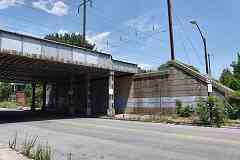|
URR's original alignment is shown more clearly on this 1915 map.
Dashed lines represent not-yet-built streets that may have been
surveyed at the time. The Dreadnaught Tire and
Rubber Company saw rail service along URR's original route at top.
Property boundaries are represented by solid thin lines. They
recall URR's route past the Steiner Mantel Company at the
easternmost bit of URR track that remained operational in 1915.
Beyond that, note the right-of-way's extra width along the main
line, a remnant of URR's adjacent original alignment.
Orangeville Station, a small shelter, was not on the main line
because it was used primarily by railroad employees to access the
nearby repair shops. Locating it between the main line and leg to
Canton would have permitted trains on both lines to serve it.
"LP" marks Leonard Paper's home since 1979, sited between URR's
original line and leg south to Canton. The property line west of
LP is curved to match the former leg. Their meeting point,
called both Canton Crossing Junction and Canton Junction by PRR,
was moved south when the second alignment was constructed
during 1893.
| 






















